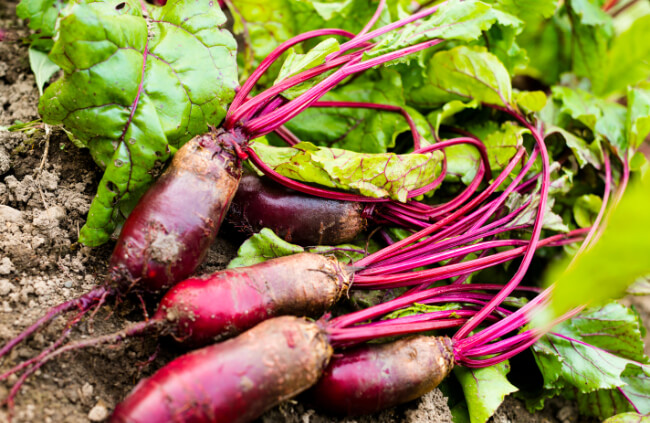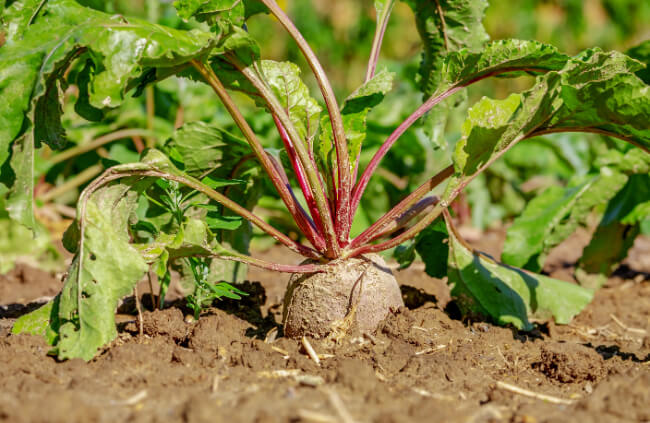Beetroots are a great crop for anyone looking to be more sustainable, especially if you’re thinking more about preserves and longer-term storage. With a little love, some well-prepared soil, and kind weather, you can get a pretty good harvest from as little as a 30 cm square patch of ground.
Growing the perfect beetroots is tricky, but even overgrown roots and underdeveloped beets are still a delicious treat, so don’t beat yourself up if you get it wrong (pun intended).
We’ve got tips and tricks about growing the perfect beets in our main beetroot guide, but cylindra needs a slightly deeper root run, and a little bit more care when it comes to pests, so use the guide below to grow this slender, juicy beetroot variety.
More...

Family: | Amaranthaceae |
|---|---|
Genus: | Beta |
Species: | B. vulgaris |
Origin: | Mediterranean |
Common Names: | Beetroot ‘Cylindra’, Cylindra Beet |
Location: | Outdoor |
Type: | Root vegetable |
Growth: | 25cm (H) x 15cm (W) |
Sun requirements: | Full sun or part shade |
Foliage Colour: | Green |
Flower Colour: | White-Green |
Flowering: | Summer in the second year |
Edible Parts: | Edible roots and leaves |
Maintenance level: | Low |
Poisonous for pets: | Non-toxic to cats and dogs |
What is Beetroot ‘Cylindra’?
Beetroot ‘Cylindra’ is a gorgeously bred cultivar of beetroot, sometimes called beets. While its flavour is pretty much the same as any other beetroot (earthy, slow to develop, and packed with mineral rich notes that create a smooth but irony flavour), it’s flesh is more tender making it perfect for blitzing into smoothies, sauces, or even making a beet ketchup.
Physically, the clue to its difference is in the name, with its roots growing long, not round, creating something that looks more like a smooth carrot.
Growing Cylindra Beetroot in Australia
Beetroot ‘Cylindra’ is simple to grow, but like nearly all root veggies, it needs slightly different care at different growth stages. The only real difference between its growing conditions and most globe beetroots is that it requires a deeper root run, and more soil preparation to ensure its roots can develop without obstruction.

How to Propagate Beetroot ‘Cylindra’ from Seed
You can grow Beetroot ‘Cylindra’ from seed at any time of year in most parts of Australia, but they don’t like being drenched, which can split the root, and rot young developing roots, and don’t like temperatures below 10°C.
In cooler parts of Australia and Tasmania, it’s worth aiming for spring sowings to get an early summer harvest. For subtropical parts of Australia, sow in June or July when the weather is cooler and rainfall is lower.
If you’re unsure or want to play it safe, sow Beetroot ‘Cylindra’ indoors in module trays and carefully plant them out when they are large enough to handle. This simply mitigates the risk or the shock of extreme cold or damp temperatures on very young plants.
Sowing Beetroot ‘Cylindra’ Outdoors
Sowing Beetroot ‘Cylindra’ directly outdoors is a reliable and easy way to get a harvest. Follow the steps below:
- Prepare your ground by digging through any organic peat-free compost and weeding out any seedlings or roots.
- Rake until it has a fine surface texture and remove any large stones or lumps of clay (this is especially important for Beetroot ‘Cylindra’ which needs clear root space).
- Dig drills 1-3 cm deep and 15 cm apart by drawing a line in the soil surface with a bamboo cane.
- Sow seeds thinly along each drill (5-10 cm apart).
- Mark the lines at each end.
- Cover the drills over.
- Water well and keep the soil moist until they germinate.
How to Sow Beetroot ‘Cylindra’ Indoors
Sowing Beetroot ‘Cylindra’ indoors will help to reduce the risk of frost damage, heavy rain, or baked roots depending on where you live. If you want to play it safe and don’t mind adding a few extra steps to growing Beetroot ‘Cylindra’, follow the steps below:
- Fill a module tray with a free draining mix of loose compost. I use a coir based compost by itself, which holds moisture, but allows roots to develop well without getting too wet.
- Push one Beetroot ‘Cylindra’ seed into the centre of each module and water well.
- Place somewhere bright but out of any direct afternoon sunlight.
- Cover with a propagator lid or plastic bag to retain moisture until it germinates.
- Remove the cover, and keep the compost moist.
- Plant out when they are big enough to handle.
Spacing Beetroot ‘Cylindra’
Whether you’re planting beetroot seedlings, or sowing seeds, Beetroot ‘Cylindra’ needs enough space for its foliage as well as its root. Beetroot ‘Cylindra’ roots can grow to about 8 cm wide, but their leaves are about 20 cm across, so leave 15 cm between each plant so they have enough space to breathe.
Sow seeds 5-10 cm apart, and thin them down to 20 cm when they reach 10 cm tall (you can use Beetroot ‘Cylindra’ leaves in salads for a deliciously sweet leafy addition to any meal).
Caring for Cylindra Beetroot

Where to Plant Beetroot ‘Cylindra’
Before you do any of that though, it’s essential that you get the soil conditions just right, and make sure they are planted somewhere with bright light and access to moisture.
Soil & Drainage
In my sunniest beds, I mitigate the moisture loss from the sun by adding a layer of rotted manure to the base of the bed, then backfilling with garden soil and compost. The manure holds moisture which draws the roots downwards, creating longer, tenderer roots.
In slightly more shaded positions, I plant Beetroot ‘Cylindra’ directly into the soil, with a few big scoops of compost dug through to help loosen and feed the ground before planting.
Light Requirements
Beetroot ‘Cylindra’ prefers full sun, but will grow surprisingly well in dappled shade. Like chard, which is closely related, they are a useful addition to shady borders as ornamental veggies, but you’ll get a much better crop from a sunny spot.
Watering & Feeding Beetroot ‘Cylindra’
Watering your Beetroot ‘Cylindra’ is really important to get right. As seedlings, too much water can kill them. As young plants, too little water will stunt their development. As mature plants that are ready to harvest, too much, or too little water can cause the root to split making it nearly impossible to store.
Beetroot ‘Cylindra’ seedlings should be watered lightly until they begin to form a fleshy root. When you begin to see the shoulders of the beetroot, begin to water heavily once every two to three days, allowing the soil to dry slightly each time.
When they are ready to harvest (the best way to check is to gently dig down around the root and have a look), slow down watering so that the soil is slightly moist but not damp, and don’t let it dry out completely.
As you are about to harvest, because Beetroot ‘Cylindra’ has long, delicate roots, water the soil very, very thoroughly, as this will make it far easier to pull the roots up without damaging them.
Harvesting Beetroot ‘Cylindra’
Beetroot ‘Cylindra’ is ready to harvest when its shoulders are poking out of the ground, and starting to look a little bit dry on top. If the leaves are starting to wilt down, it’s also a sign that the root has done its job for the year.
To be sure, dig around a few roots to check their size, and if you give them a gentle squeeze they should be firm, with slightly squeaky skin. Then water the bed, and pull it up with your hand around the root, not the leaves.

How to Store Beetroot ‘Cylindra’
If your Beetroot ‘Cylindra’ still has happy healthy leaves when you harvest it, use them immediately in salads, if they’ve started to wilt, add them to your compost.
To store Beetroot ‘Cylindra’, use any basic pickle recipe for long-term storage, or blanch and freeze them for a fresher flavour (this will ruin their texture, but they’ll work perfectly for soups.
Beetroot ‘Cylindra’ Pests and Diseases
Beetroot ‘Cylindra’ doesn’t have many common pests, but carrot flies can damage them extensively if they are already in the bed. Avoid following carrots with any beetroot variety for that reason, particularly cylindra.
Beetroot ‘Cylindra’ FAQs
How long does it take to harvest Beetroot ‘Cylindra’ from seed?
Beetroot ‘Cylindra’ takes about 70 days from sowing to harvest. Winter sowing is a little slower, but you can speed them up by sowing indoors and planting out when they are large enough to handle.
How big do cylindra beetroots grow?
Cylindra beetroot grows to about 15 cm long in good conditions, and 5-8 cm wide – roughly the shape of a very fat carrot.
What’s the best way to use Beetroot ‘Cylindra’?
The best way to use Beetroot ‘Cylindra’ is fresh, sliced into salads. As a smoother, slower-flavoured beetroot, cylindra doesn’t need cooking or pickling to soften it, and it is gorgeous in pretty much any recipe.
Looking to grow more root vegetables in your garden? Check out our complete guide from growing to harvesing taros and potatoes in Australia.
Wrapping Up Our Cylindra Growing Guide
Beetroot ‘Cylindra’ is one of my favourite vegetables to grow, and can be very forgiving too. If you leave them in the ground for too long, they’ll turn woody, but they’re still delicious when boiled and blitzed, or dried into crisps.
Make sure you take care to avoid overly damp, hot, or wet conditions. Get started on growing your own Beetroot ‘Cylindra’ at home now, wherever you are.
Published on June 8, 2023 by Maisie Blevins
Last Updated on February 23, 2024




